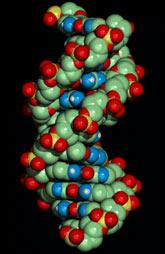Genetics, Behaviour and Coat Colour
Do they combine?
Quite many studies suggest that there is a genetic relationship between behaviour and coat/plumage colour, but so far none have stated any genes responsible for it. Not untill very recently.

Mutations in a gene called PMEL17, controlling expression of the pigment molecule eumelanin, have in resent studies shown to protect against damage caused by feather pecking. Black birds with functional PMEL17 genes had worse plumage condition than white birds with non-functional PMEL17 genes. With other words: black birds were more victimized.
The aim of my study was to confirm this relationship by direct observations of the feather pecking behaviour. Additionally, I wanted to take the first step to investigate the mechanism behind the black pecking preference by utilizing different kinds of behavioural tests.
For my help, I had a fifth generation of an inbred cross between Red jungle fowl and White leghorn. The darker Red jungle fowl (Gallus gallus), which is the ancestor to all of our domestic chickens, have functional PMEL17 genes, while the lighter White leghorn, which is a chicken breed highly selected for egg production, have non-functional PMEL17 genes.
After five generations of inbreeding I was in an unique position to investigate this gene further, because the birds was in a perfect genetic mess between the Red jungle fowl and White leghorn. But first, to accomplish my aims, I had to know which of birds that carried functional respectively non-functional PMEL17 genes, so I genotyped the parents to control if the offspring would carry the mutation or not. With the knowledge that the genetics were randomized accept on one single gene, I hypothesized that any difference seen between black and white birds could depend on PMEL17. That’s where behavioural testing comes in.
What did I find then? My observations of peck behaviours confirm that birds carrying functional PMEL17 genes were more feather pecked than birds carrying mutated genes. A feather preference test, where birds could choose to peck at either black or white feathers, disclosed that immobile feathers are not enough to trigger black directed pecking preference. Furthermore, behaviours in an open-field arena revealed that black birds vocalized more and earlier than white birds, while in a fear for human test whites showed a higher degree of activity at around 21 weeks of age. This suggests that PMEL17 could have something to do with how urgent it is for the birds to get in contact with flock mates (a social parameter), as well as how they behave in early sexual maturation that happens to occur at about 20 weeks of age.

Conclusively, black birds with functional PMEL17 alleles are feather pecked more and behave differently then white birds carrying mutated alleles. Personally I think that the arguments for a genetic origin weigh very strong. For example: Why be more social if close contact to pen mates causes pain? Of course further studies are needed to mark the behavioural and genetic core of the problem, before any physiological investigation of these differences could be initiated. But there are something interesting about chicken and their colours...
Responsible for this page:
Director of undergraduate studies Biology
Last updated:
05/24/05

